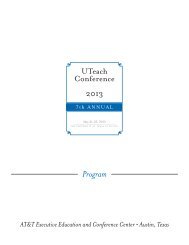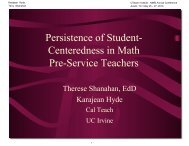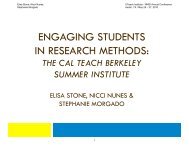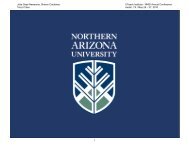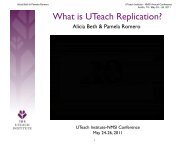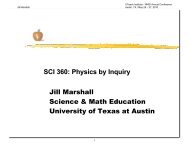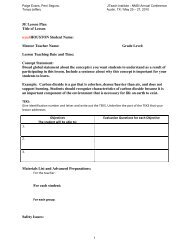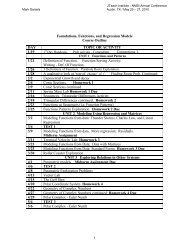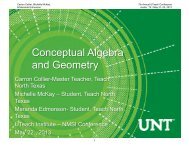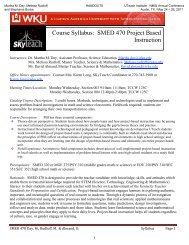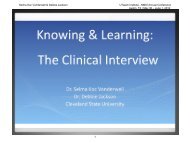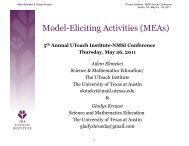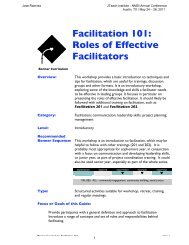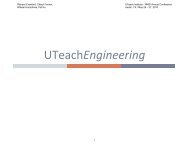John Quintanilla & Carron Collier UTeach Institute - NMSI Annual ...
John Quintanilla & Carron Collier UTeach Institute - NMSI Annual ...
John Quintanilla & Carron Collier UTeach Institute - NMSI Annual ...
Create successful ePaper yourself
Turn your PDF publications into a flip-book with our unique Google optimized e-Paper software.
<strong>John</strong> <strong>Quintanilla</strong> & <strong>Carron</strong> <strong>Collier</strong> <strong>UTeach</strong> <strong>Institute</strong> - <strong>NMSI</strong> <strong>Annual</strong> Conference<br />
Austin, TX / May 30 – June 1, 2012<br />
1
<strong>John</strong> <strong>Quintanilla</strong> & <strong>Carron</strong> <strong>Collier</strong> <strong>UTeach</strong> <strong>Institute</strong> - <strong>NMSI</strong> <strong>Annual</strong> Conference<br />
Austin, TX / May 30 – June 1, 2012<br />
2
<strong>John</strong> <strong>Quintanilla</strong> & <strong>Carron</strong> <strong>Collier</strong> <strong>UTeach</strong> <strong>Institute</strong> - <strong>NMSI</strong> <strong>Annual</strong> Conference<br />
Austin, TX / May 30 – June 1, 2012<br />
3
<strong>John</strong> <strong>Quintanilla</strong> & <strong>Carron</strong> <strong>Collier</strong> <strong>UTeach</strong> <strong>Institute</strong> - <strong>NMSI</strong> <strong>Annual</strong> Conference<br />
Austin, TX / May 30 – June 1, 2012<br />
4
<strong>John</strong> <strong>Quintanilla</strong> & <strong>Carron</strong> <strong>Collier</strong> <strong>UTeach</strong> <strong>Institute</strong> - <strong>NMSI</strong> <strong>Annual</strong> Conference<br />
Austin, TX / May 30 – June 1, 2012<br />
5
<strong>John</strong> <strong>Quintanilla</strong> & <strong>Carron</strong> <strong>Collier</strong> <strong>UTeach</strong> <strong>Institute</strong> - <strong>NMSI</strong> <strong>Annual</strong> Conference<br />
Austin, TX / May 30 – June 1, 2012<br />
6
<strong>John</strong> <strong>Quintanilla</strong> & <strong>Carron</strong> <strong>Collier</strong> <strong>UTeach</strong> <strong>Institute</strong> - <strong>NMSI</strong> <strong>Annual</strong> Conference<br />
Austin, TX / May 30 – June 1, 2012<br />
7
<strong>John</strong> <strong>Quintanilla</strong> & <strong>Carron</strong> <strong>Collier</strong> <strong>UTeach</strong> <strong>Institute</strong> - <strong>NMSI</strong> <strong>Annual</strong> Conference<br />
Austin, TX / May 30 – June 1, 2012<br />
8
<strong>John</strong> <strong>Quintanilla</strong> & <strong>Carron</strong> <strong>Collier</strong> <strong>UTeach</strong> <strong>Institute</strong> - <strong>NMSI</strong> <strong>Annual</strong> Conference<br />
Austin, TX / May 30 – June 1, 2012<br />
9
<strong>John</strong> <strong>Quintanilla</strong> & <strong>Carron</strong> <strong>Collier</strong> <strong>UTeach</strong> <strong>Institute</strong> - <strong>NMSI</strong> <strong>Annual</strong> Conference<br />
Austin, TX / May 30 – June 1, 2012<br />
10
<strong>John</strong> <strong>Quintanilla</strong> & <strong>Carron</strong> <strong>Collier</strong> <strong>UTeach</strong> <strong>Institute</strong> - <strong>NMSI</strong> <strong>Annual</strong> Conference<br />
Austin, TX / May 30 – June 1, 2012<br />
11
<strong>John</strong> <strong>Quintanilla</strong> & <strong>Carron</strong> <strong>Collier</strong> <strong>UTeach</strong> <strong>Institute</strong> - <strong>NMSI</strong> <strong>Annual</strong> Conference<br />
Austin, TX / May 30 – June 1, 2012<br />
12
<strong>John</strong> <strong>Quintanilla</strong> & <strong>Carron</strong> <strong>Collier</strong> <strong>UTeach</strong> <strong>Institute</strong> - <strong>NMSI</strong> <strong>Annual</strong> Conference<br />
Austin, TX / May 30 – June 1, 2012<br />
13
<strong>John</strong> <strong>Quintanilla</strong> & <strong>Carron</strong> <strong>Collier</strong> <strong>UTeach</strong> <strong>Institute</strong> - <strong>NMSI</strong> <strong>Annual</strong> Conference<br />
Austin, TX / May 30 – June 1, 2012<br />
14
<strong>John</strong> <strong>Quintanilla</strong> & <strong>Carron</strong> <strong>Collier</strong> <strong>UTeach</strong> <strong>Institute</strong> - <strong>NMSI</strong> <strong>Annual</strong> Conference<br />
Austin, TX / May 30 – June 1, 2012<br />
15
<strong>John</strong> <strong>Quintanilla</strong> & <strong>Carron</strong> <strong>Collier</strong> <strong>UTeach</strong> <strong>Institute</strong> - <strong>NMSI</strong> <strong>Annual</strong> Conference<br />
Austin, TX / May 30 – June 1, 2012<br />
16
<strong>John</strong> <strong>Quintanilla</strong> & <strong>Carron</strong> <strong>Collier</strong> <strong>UTeach</strong> <strong>Institute</strong> - <strong>NMSI</strong> <strong>Annual</strong> Conference<br />
Austin, TX / May 30 – June 1, 2012<br />
17
<strong>John</strong> <strong>Quintanilla</strong> & <strong>Carron</strong> <strong>Collier</strong> <strong>UTeach</strong> <strong>Institute</strong> - <strong>NMSI</strong> <strong>Annual</strong> Conference<br />
Austin, TX / May 30 – June 1, 2012<br />
18
<strong>John</strong> <strong>Quintanilla</strong> & <strong>Carron</strong> <strong>Collier</strong> <strong>UTeach</strong> <strong>Institute</strong> - <strong>NMSI</strong> <strong>Annual</strong> Conference<br />
Austin, TX / May 30 – June 1, 2012<br />
19
<strong>John</strong> <strong>Quintanilla</strong> & <strong>Carron</strong> <strong>Collier</strong> <strong>UTeach</strong> <strong>Institute</strong> - <strong>NMSI</strong> <strong>Annual</strong> Conference<br />
Austin, TX / May 30 – June 1, 2012<br />
20
<strong>John</strong> <strong>Quintanilla</strong> & <strong>Carron</strong> <strong>Collier</strong> <strong>UTeach</strong> <strong>Institute</strong> - <strong>NMSI</strong> <strong>Annual</strong> Conference<br />
Austin, TX / May 30 – June 1, 2012<br />
21
<strong>John</strong> <strong>Quintanilla</strong> & <strong>Carron</strong> <strong>Collier</strong> <strong>UTeach</strong> <strong>Institute</strong> - <strong>NMSI</strong> <strong>Annual</strong> Conference<br />
Austin, TX / May 30 – June 1, 2012<br />
22
<strong>John</strong> <strong>Quintanilla</strong> & <strong>Carron</strong> <strong>Collier</strong> <strong>UTeach</strong> <strong>Institute</strong> - <strong>NMSI</strong> <strong>Annual</strong> Conference<br />
Austin, TX / May 30 – June 1, 2012<br />
23
<strong>John</strong> <strong>Quintanilla</strong> & <strong>Carron</strong> <strong>Collier</strong> <strong>UTeach</strong> <strong>Institute</strong> - <strong>NMSI</strong> <strong>Annual</strong> Conference<br />
Austin, TX / May 30 – June 1, 2012<br />
24
<strong>John</strong> <strong>Quintanilla</strong> & <strong>Carron</strong> <strong>Collier</strong> <strong>UTeach</strong> <strong>Institute</strong> - <strong>NMSI</strong> <strong>Annual</strong> Conference<br />
Austin, TX / May 30 – June 1, 2012<br />
25
<strong>John</strong> <strong>Quintanilla</strong> & <strong>Carron</strong> <strong>Collier</strong> <strong>UTeach</strong> <strong>Institute</strong> - <strong>NMSI</strong> <strong>Annual</strong> Conference<br />
Austin, TX / May 30 – June 1, 2012<br />
26
<strong>John</strong> <strong>Quintanilla</strong> & <strong>Carron</strong> <strong>Collier</strong> <strong>UTeach</strong> <strong>Institute</strong> - <strong>NMSI</strong> <strong>Annual</strong> Conference<br />
Austin, TX / May 30 – June 1, 2012<br />
27
<strong>John</strong> <strong>Quintanilla</strong> & <strong>Carron</strong> <strong>Collier</strong> <strong>UTeach</strong> <strong>Institute</strong> - <strong>NMSI</strong> <strong>Annual</strong> Conference<br />
Austin, TX / May 30 – June 1, 2012<br />
28
<strong>John</strong> <strong>Quintanilla</strong> & <strong>Carron</strong> <strong>Collier</strong> <strong>UTeach</strong> <strong>Institute</strong> - <strong>NMSI</strong> <strong>Annual</strong> Conference<br />
Austin, TX / May 30 – June 1, 2012<br />
29
<strong>John</strong> <strong>Quintanilla</strong> & <strong>Carron</strong> <strong>Collier</strong> <strong>UTeach</strong> <strong>Institute</strong> - <strong>NMSI</strong> <strong>Annual</strong> Conference<br />
Austin, TX / May 30 – June 1, 2012<br />
30
<strong>John</strong> <strong>Quintanilla</strong> & <strong>Carron</strong> <strong>Collier</strong> <strong>UTeach</strong> <strong>Institute</strong> - <strong>NMSI</strong> <strong>Annual</strong> Conference<br />
Austin, TX / May 30 – June 1, 2012<br />
31
<strong>John</strong> <strong>Quintanilla</strong> & <strong>Carron</strong> <strong>Collier</strong> <strong>UTeach</strong> <strong>Institute</strong> - <strong>NMSI</strong> <strong>Annual</strong> Conference<br />
Austin, TX / May 30 – June 1, 2012<br />
32
<strong>John</strong> <strong>Quintanilla</strong> & <strong>Carron</strong> <strong>Collier</strong> <strong>UTeach</strong> <strong>Institute</strong> - <strong>NMSI</strong> <strong>Annual</strong> Conference<br />
Austin, TX / May 30 – June 1, 2012<br />
33
<strong>John</strong> <strong>Quintanilla</strong> & <strong>Carron</strong> <strong>Collier</strong> <strong>UTeach</strong> <strong>Institute</strong> - <strong>NMSI</strong> <strong>Annual</strong> Conference<br />
Austin, TX / May 30 – June 1, 2012<br />
34
<strong>John</strong> <strong>Quintanilla</strong> & <strong>Carron</strong> <strong>Collier</strong> <strong>UTeach</strong> <strong>Institute</strong> - <strong>NMSI</strong> <strong>Annual</strong> Conference<br />
Austin, TX / May 30 – June 1, 2012<br />
35
<strong>John</strong> <strong>Quintanilla</strong> & <strong>Carron</strong> <strong>Collier</strong> <strong>UTeach</strong> <strong>Institute</strong> - <strong>NMSI</strong> <strong>Annual</strong> Conference<br />
Austin, TX / May 30 – June 1, 2012<br />
36
<strong>John</strong> <strong>Quintanilla</strong> & <strong>Carron</strong> <strong>Collier</strong> <strong>UTeach</strong> <strong>Institute</strong> - <strong>NMSI</strong> <strong>Annual</strong> Conference<br />
Austin, TX / May 30 – June 1, 2012<br />
37
<strong>John</strong> <strong>Quintanilla</strong> & <strong>Carron</strong> <strong>Collier</strong> <strong>UTeach</strong> <strong>Institute</strong> - <strong>NMSI</strong> <strong>Annual</strong> Conference<br />
Austin, TX / May 30 – June 1, 2012<br />
38
<strong>John</strong> <strong>Quintanilla</strong> & <strong>Carron</strong> <strong>Collier</strong> <strong>UTeach</strong> <strong>Institute</strong> - <strong>NMSI</strong> <strong>Annual</strong> Conference<br />
Austin, TX / May 30 – June 1, 2012<br />
39
<strong>John</strong> <strong>Quintanilla</strong> & <strong>Carron</strong> <strong>Collier</strong><br />
Many problems are taken from the following sources:<br />
• Richard J. Crouse and Clifford W. Sloyer, Mathematical<br />
Questions from the Classroom, Parts I and II, Janson<br />
Publications, Providence, 1987.<br />
• Ira J. Papick, “Strengthening the Mathematical Content<br />
Knowledge of Middle and Secondary Mathematics Teachers,”<br />
Notices of the American Mathematical Society, Vol.<br />
58, No. 3 (March 2011), pp. 389–392.<br />
1. A seventh-grade student asks you, “Why when multiplying<br />
or dividing decimals do we put the decimal point<br />
where we do?”<br />
2. You make the statement that 1.9 = 2. Some of your<br />
students protest, saying that the above statement is impossible<br />
because you have nines all the time after the<br />
decimal point.<br />
3. A bright student asks, “I noticed the following pattern:<br />
256 × 256 = 65, 536,<br />
257 × 257 = 66, 049,<br />
258 × 258 = 66, 564.<br />
Is there a reason why the last two digits are always perfect<br />
squares? I know it usually doesn’t work out this way.”<br />
4. A student asks, “Why does the finger trick for multiplying<br />
by 9 work?”<br />
5. A student asks, “Why does the telephone trick for multiplying<br />
by 7 work?”<br />
6. A student asks, “What is 0 −7 ?”<br />
7. A student asks, “Why is x 0 = 1?”<br />
8. A student asks, “You said |a| = −a, but how can the<br />
absolute value of a number be negative?<br />
9. A student asks, “My father was helping me with my<br />
homework last night and he said the book is wrong. He<br />
said that √ 4 = 2 and √ 4 = −2, because 2 2 = 4 and<br />
(−2) 2 = 4, but the book says that √ 4 = −2. He wants<br />
to know why we are using a book that has mistakes.”<br />
10. A student explains that 1 2 3<br />
5 + 3 = 8 as follows: “If a<br />
baseball player is up at bat 5 times on the first day and<br />
gets one hit, and on the second day he gets 2 hits out of<br />
3 at-bats, then altogether he has 3 hits out of 8 at-bats.”<br />
11. A student asks, “Can you divide fractional numbers by<br />
separately dividing the numerators and the denominators?”<br />
For example,<br />
14<br />
9<br />
2 14 ÷ 2 7<br />
÷ = =<br />
3 9 ÷ 3 3 .<br />
12. An eighth-grade student hands in the following solution:<br />
64 6/4 4<br />
= = = 4.<br />
16 16/ 1<br />
Handouts <strong>UTeach</strong> <strong>Institute</strong> - <strong>NMSI</strong> <strong>Annual</strong> Conference<br />
Austin, TX / May 30 – June 1, 2012<br />
1<br />
Handouts - 1<br />
13. A student asks, “My teacher from last year told me that<br />
whatever I do to one side of an equation, I must do the<br />
same thing to the other side to keep the equality true. I<br />
cant figure out what Im doing wrong by adding 1 to the<br />
numerator of both fractions in the equality 1<br />
getting 2<br />
2<br />
= 3<br />
4 .<br />
2<br />
= 2<br />
4 and<br />
14. You are teaching division of fractions. A seventh-grader<br />
asks, “Why does multiplying by the reciprocal of the divisor<br />
give the correct answer?”<br />
15. A student in your class asks, “Why don’t we need to get<br />
common denominators when multiplying fractions?”<br />
16. You have given your class the following problem: “A 20foot<br />
board is to be cut into shorter pieces. If each piece<br />
is 4 3<br />
4 feet long, how many pieces will there be?” One<br />
student hands in the following work:<br />
“20 ÷ 4 3 19 4 80 4<br />
= 20 ÷ = 20 = = 4<br />
4 4 19 19 19 .<br />
Thus there are 4 pieces and 4/19 of a foot left over.”<br />
17. You are teaching your students the idea of the degree<br />
measure of an angle and you have related it to the circle.<br />
One student makes the assertion that the degree will<br />
vary because the angle intercepts arc of different lengths<br />
depending on the size of the circle.<br />
18. A student asks, “Is a straight angle of 180 ◦ really an<br />
angle?”<br />
19. You ask your eighth-grade students to find the area of<br />
a circle with a radius of 5 inches. One of your students<br />
answers, “A circle is defined to be the set of all points a<br />
fixed distance away from a given point. So we cannot find<br />
the area of a circle; we can only find its circumference.”<br />
Is the student right?<br />
20. While you are teaching your class the formulas for simple<br />
polygons (triangle, square, etc.), a student excitedly says<br />
that she has a formula that does it all: A = 1<br />
2h(t + b)<br />
where<br />
• A is the area of the polygon,<br />
• h is the height,<br />
• t is the length of the top segment,<br />
• b is the length of the bottom segment.<br />
21. A student in your eighth-grade class is trying to solve the<br />
following problem: “A man drives a car for one mile at<br />
60 miles per hour and for another mile at 120 miles per<br />
hour. What is his average speed?” The student reasons<br />
that the answer should be (60 + 120)/2 = 90 miles per<br />
hour.<br />
22. A student asks, “When you subtract two negatives, why<br />
do you have to change the sign of the subtrahend?”
<strong>John</strong> <strong>Quintanilla</strong> & <strong>Carron</strong> <strong>Collier</strong><br />
23. A student asks, “12 is a factor of 72, and also 72 has 12<br />
factors. How many numbers are there like that?”<br />
24. You have explained that 0 ÷ 0 is undefined because the<br />
value could have too many answers. A student asks,<br />
“Why can’t we just define 0 ÷ 0 to be equal to one and<br />
always use it that way?”<br />
25. A student asks, “Why isn’t 1 a prime number?”<br />
26. You ask a student to find 28% of 50. A student’s solution:<br />
“28 × 0.5 = 14.” Is this student correct?<br />
27. A student asks, “My father bought a house for $200,000<br />
at 12% interest. He told me that by the time he finishes<br />
paying for the house, it will have cost him more than<br />
$500,000. How is that possible? 12% of $200,000 is only<br />
$24,000.”<br />
28. A student asks, “If 5 2 = 25 and (−5) 2 = 25, then why<br />
doesn’t √ 25 = ±5?”<br />
29. A student asks, “Why aren’t ‘|x + y| = 5’ and ‘|x| + |y| =<br />
5’ the same?”<br />
30. A student asks, “Why does the book say that a polynomial<br />
anx n + an−1x n−1 + . . . + a1x + a0 = 0 if and only if<br />
each ai = 0, and then later says that 2x 2 + 5x + 3 = 0?<br />
31. A student hands in the following work:<br />
x + 6<br />
2<br />
= x + 6/3<br />
2/<br />
= x + 3<br />
When the student asks why he can’t cancel the 2 into the<br />
6, how would you answer?<br />
32. A tenth-grade student hands in the following work:<br />
x 2/ − y 2/<br />
x/ + y/<br />
= x − y<br />
33. A student asks, “My algebra teacher said<br />
x 2 + x − 6<br />
x − 2<br />
(x + 3)(x − 2)<br />
= = x + 3,<br />
x − 2<br />
but my sisters boyfriend (who is in college) says that<br />
they are not equal, because the original expression is not<br />
defined at 2, but the other expression equals 5 when evaluated<br />
at 2.”<br />
34. A student asks you if √ a 2 + b 2 = a + b.<br />
35. A student presents the following work:<br />
4x 2 − 23x + 15 = 0<br />
t 2 − 23t + (15)(4) = 0<br />
t 2 − 23t + 60 = 0<br />
(t − 20)(t − 3) = 0<br />
t = 20 or t = 3<br />
Therefore, x = 20/4 = 5 or x = 3/4.<br />
Handouts <strong>UTeach</strong> <strong>Institute</strong> - <strong>NMSI</strong> <strong>Annual</strong> Conference<br />
Austin, TX / May 30 – June 1, 2012<br />
2<br />
Handouts - 2<br />
36. A ninth-grade student says, “Since (a · b) 2 = a 2 · b 2 , we<br />
can follow the pattern so that (a + b) 2 = a 2 + b 2 .”<br />
37. A student asks, “I understand why you would want to<br />
square or cube a number. But why would I want to raise<br />
a number to a fractional exponent?”<br />
38. You are asked, “How would you evaluate 232? Is it 82 =<br />
64 or 29 = 512?”<br />
39. A student asks, “We know how to define 3 2 , but how do<br />
we define 3 2.5 or 3 √ 2 ?<br />
40. A student presents the following work:<br />
y 2 −2xy+x 2 −w 2 = (y−x) 2 −w 2 = (y−x+w)(y−x−w).<br />
Another student presents the following:<br />
x 2 −2xy+y 2 −w 2 = (x−y) 2 −w 2 = (x−y+w)(x−y−w).<br />
Which way is correct?<br />
41. A student presents the following work:<br />
x 2 − 14x + 24 = 3<br />
(x − 12)(x − 2) = 3<br />
(x − 12)(x − 2) = 3 · 1<br />
x − 12 = 3 or x − 2 = 1<br />
x = 15 or x = 3<br />
42. You give your students the following problem: “Graph<br />
x = 3.” One student shows an xy−graph with a vertical<br />
line with x−intercept 3. Another student shows a<br />
number line with a closed circle on the number 3. Which<br />
student is correct?<br />
43. A student asks you if a line having zero slope means the<br />
same thing as having no slope.<br />
44. In your ninth-grade algebra class, you are asked, “Does<br />
(a + b)(c + d) = ac + bd?”<br />
45. In a discussion on rates, a student says, “If I walk 4 mph<br />
for one mile, I’ll have to run 8 mph the second mile in<br />
order to average 6 mph for 2 miles. Right?”<br />
46. A student asks you if<br />
1 1 1<br />
= +<br />
a + b a b .<br />
47. A student hands in the following work: (6t) √ 3 =<br />
(6 √ 3)(t √ 3).<br />
48. A student provides the following work: (3+x)−(x−5) =<br />
3 + (x − x) − 5 = 3 − 5 = −2.<br />
49. You make the statement that the polynomial x 2 − 2 cannot<br />
be factored. One student says, “Yes it can, because<br />
x 2 −2 = (x− √ 2)(x+ √ 2). What reply would you make?<br />
50. While discussing cube roots, you ask the class to compute<br />
3√ 16 + 3 √ −16. A student says that the answer is zero<br />
because 16 − 16 = 0. Is the student right?
<strong>John</strong> <strong>Quintanilla</strong> & <strong>Carron</strong> <strong>Collier</strong><br />
51. In response to the question, “What is √ x 2 ?”, a student<br />
says the answer is x.<br />
52. A student asks, “Why isn’t √ 3 + √ 12 = √ 15?”<br />
53. A student asks, “Why isn’t (−2) 2 (−2)<br />
=<br />
1 2· (−2) 2 =<br />
1 = −2?<br />
54. A student is trying to solve the set of simultaneous linear<br />
equations:<br />
2x + 3y = 6<br />
−6x − 9y = −14<br />
He comes up with 0 = 4 but doesn’t know what it means.<br />
55. The problem is: <strong>John</strong> rows up the river at 6 mph and<br />
down the river at 8 mph. What would <strong>John</strong>’s rate be in<br />
still water and what is the rate of the current of the river?<br />
A student says, “To solve this, I add 6 mph and 8 mph<br />
and divide by 2. So <strong>John</strong>’s rate in still water is 7 mph.<br />
To find the rate of the current, I subtract 7 from 8 or else<br />
subtract 6 from 7. The rate of the current is 1 mph.” Is<br />
the student correct?<br />
56. After showing students how to bisect an angle, how do<br />
you answer the student who asks, “Is it possible to divide<br />
an angle into three equal parts?”<br />
57. A student asks, “If the word point is undefined, how is it<br />
possible to use something that is not really there?”<br />
58. A student asks, “What is the difference between necessary<br />
and sufficient in the statement and proof of a theorem?”<br />
59. A student asks you why axioms are not proved as theorems<br />
are.<br />
60. While studying circles in geometry class, a student asks<br />
you what is the relationship between a tangent to a circle<br />
and the tangent of an angle.<br />
61. You ask your students to draw two circles such that they<br />
have three common tangents. One student says it can’t<br />
be done. Is the student right?<br />
62. A student asks you if all circles are similar.<br />
63. A student asks, “Can circles be circumscribed only about<br />
regular polygons?”<br />
64. A student asks, “Why is there no SSA or AAA postulate?”<br />
65. A student asks, “In graphing an inequality of the form<br />
ax + by < c, why is it sufficient to test only one point,<br />
not on ax + by = c, to find which region to shade?”<br />
66. You ask your class if the following statement is true or<br />
false: If not a square, then not a rhombus. One student<br />
says that “if not a square” implies that it could be a<br />
rectangle and a rectangle is not a rhombus. Therefore<br />
the statement is true. Do you agree?<br />
Handouts <strong>UTeach</strong> <strong>Institute</strong> - <strong>NMSI</strong> <strong>Annual</strong> Conference<br />
Austin, TX / May 30 – June 1, 2012<br />
3<br />
Handouts - 3<br />
67. During a lesson on indirect proofs, a student says, “Why<br />
do we have to assume the opposite of the conclusion?<br />
Why can’t we assume the opposite of the given and try<br />
to contradict the conclusion?”<br />
68. You ask a student to give you the negation of “All men<br />
are good.” The student says the negation would be “All<br />
men are not good.”<br />
69. You ask your students to put the following statement into<br />
“if-then” form: Two planes intersect provided that they<br />
are not parallel. One student writes, “If two planes intersect,<br />
then they are not parallel.” Is the student right?<br />
70. The problem: What is the negation of the statement<br />
“Some men are not wise?” A student replies that the<br />
negation is “Some men are wise?” Do you agree?<br />
71. A student asks, “If a regular polyhedron is made up of<br />
regular polygons and there are an infinite number of regular<br />
polygons, then why are there only five regular polyhedrons?”<br />
72. A student asks you if parallel lines meet at infinity.<br />
73. One student says that segments which have no points in<br />
common are either parallel or skew segments. Do you<br />
agree?<br />
74. A student asks, “If a line l is perpendicular to a line in<br />
the plane, is l perpendicular to the plane?”<br />
75. A student asks, “If two polygons have the corresponding<br />
angles equal, are their sides proportional?”<br />
76. A student makes the following statement: “It looks like<br />
if you join the midpoints of the sides of a quadrilateral,<br />
the resulting inscribed figure is always a parallelogram.”<br />
77. A student asks, “If we solve |x + 2| ≥ 7, we get x ≥ 5<br />
or x ≤ −9. If we solve |x + 2| ≤ 7, we get x ≤ 5 and<br />
x ≥ −9. How do we account for the use of and and or?”<br />
78. A student solves the problem |x − 5| ≥ 6 as follows:<br />
Therefore, −1 ≥ x ≥ 11.<br />
|x − 5| ≥ 6<br />
x − 5 ≥ 6 −x + 5 ≥ 6<br />
x ≥ 11 −1 ≥ x<br />
79. A student asks you if binomial coefficients are defined for<br />
fractions and negative numbers and, if so, what are the<br />
definitions?<br />
80. The problem is, Find the sum of the coefficients of<br />
(x − 2y) 18 . A student’s answer, “All you need to do is<br />
compute (1−2) 18 = (−1) 18 = 1.” Is the method correct?<br />
Is the solution correct?<br />
81. You have just shown your class Pascal’s triangle. A student<br />
then asks, “Do the diagonals of Pascal’s triangle<br />
have any interpretation?”
82. While studying Pascal’s triangle, a student asks you if<br />
there is a corresponding configuration for figuring out<br />
the coefficients of a trinomial.<br />
83. A student asks, “Why is 0! = 1?”<br />
84. A student asks if factorial can be defined for fractions or<br />
for negative numbers.<br />
85. A student asks, “We can use the quadratic formula to find<br />
the roots of any quadratic equation. Is there a similar<br />
formula for cubic equations?”<br />
86. A student’s solution:<br />
√ 2m + 1 = √ m + 3<br />
2m + 1 = m + 9<br />
m = 8<br />
87. A student solves x 2 + ix + 2 = 0 and finds that the roots<br />
are i and −2i. He then says that this example contradicts<br />
the theorem which says that if b 2 − 4ac < 0, then the<br />
equation has two complex conjugate roots.<br />
88. A student asks, “What are complex numbers good for?”<br />
89. A student makes the following observation:<br />
but<br />
<strong>John</strong> <strong>Quintanilla</strong> & <strong>Carron</strong> <strong>Collier</strong><br />
(−8) 1/3 = 3√ −8 = −2,<br />
(−8) 2/6 = 6 (−8) 2 = 2.<br />
This student then reasons that (−8) 1/3 = (−8) 2/6 even<br />
though 1/3 = 2/6.<br />
90. A student asks you if ( n√ b) n = n√ b n when b ≥ 0.<br />
91. A student asks you if there is a function that is equal to<br />
its inverse.<br />
92. A student asks, “If f has an inverse function, does that<br />
mean f is either strictly increasing or strictly decreasing?”<br />
93. A student asks, “How can f(x) = x 2 and f(t) = t 2 be<br />
the same function if different letters are used?”<br />
94. A student asks, “What is the difference between f = 0<br />
and f(x) = 0?”<br />
95. A student asks, “If f and g are periodic functions, is f +g<br />
is also periodic?”<br />
96. A student asks, “Why is an inverse function a reflection<br />
about the line y = x?”<br />
97. A student asks, “What does the graph of x 2 + y 2 = −9<br />
look like?”<br />
98. A student asks, “Isn’t a circle just a special case of an<br />
ellipse?”<br />
Handouts <strong>UTeach</strong> <strong>Institute</strong> - <strong>NMSI</strong> <strong>Annual</strong> Conference<br />
Austin, TX / May 30 – June 1, 2012<br />
4<br />
Handouts - 4<br />
99. A student asks you if the graph of y = (x 2 ) 2 = x 4 is also<br />
a parabola.<br />
100. A student comments, “A hyperbola is really just two<br />
parabolas put together.”<br />
101. A student asks you for some applications of the conic<br />
sections.<br />
102. A student asks, “If 0.9 = 1, then shouldn’t it follow that<br />
eventually a hyperbola should meet its asymptote?”<br />
103. A student asks, “How do you know for sure that some irrational<br />
number does not have a repeating decimal eventually?”<br />
104. A student asks, “How can one prove that π or e are irrational?”<br />
105. A student asks, “What is e? How does it arise in mathematics?<br />
Why does such a complicated number become<br />
so important?”<br />
106. A student asks, “Why are logarithms are important?”<br />
107. A student asks, “I have worked this problem four times,<br />
but I don’t get the answer that is in the book:<br />
log 10 4<br />
log 10 2 = log 10 4 − log 10 2 = 0.602 − 0.301 = 0.301.<br />
The answer in the book is 2. Is the book wrong?”<br />
108. A student asks, “Why doesn’t log b(x + y) = log b x +<br />
log b y?”<br />
109. A student asks you why you can’t find the log of a negative<br />
number, like ln(−1).<br />
110. A student presents the following work: √ −4 √ −9 =<br />
√ 36 = 6. Is the student correct?<br />
111. A student asks, “If √ −1 = i, then what is √ i?”<br />
112. A student asks, “Is √ −4 equal to 2i or −2i?”<br />
113. A student submits the following work:<br />
√ 4<br />
√ −9 =<br />
−4<br />
9<br />
= i2<br />
3 .<br />
114. A student asks, “Can we define < for complex numbers?<br />
For example, is it true that i < 2i?”<br />
115. A student asks you why the constant polynomial zero<br />
does not have a degree.<br />
116. A student asks, “Why can a rational function cross its<br />
horizontal asymptote but not its vertical asymptote(s)?”<br />
117. A student asks, “Aren’t the functions f(x) = x2 − 9<br />
x − 3 and<br />
g(x) = x + 3 really the same function?
<strong>John</strong> <strong>Quintanilla</strong> & <strong>Carron</strong> <strong>Collier</strong><br />
118. A student asks, “You say that a polynomial has a unique<br />
factorization of linear terms. But for ordinary factoring,<br />
there are a lot of ways that it can be done, like 12 =<br />
2 × 6 = 3 × 4. Why is this different for polynomials?”<br />
119. A student asks, “Why should we rationalize the denominator?<br />
Isn’t 1/ √ 2 just as good as √ 2/2?”<br />
120. The problem is, Find the real roots of x + √ x − 2 = 4.<br />
Using standard methods, this students finds that 3 and<br />
6 are possible solutions, but only 3 is a solution. He asks<br />
you why it is that 6 is not a solution (i.e., does not work).<br />
121. A student asks, “What good are determinants?”<br />
122. A student asks, “Why is true that sin 2 θ + cos 2 θ = 1?”<br />
123. A student asks, “What is the difference between deriving<br />
an identity and verifying an identity?”<br />
124. The problem is: Prove that sec θ − cos θ = tan θ sin θ. A<br />
student’s solution:<br />
1 − cos2 θ<br />
cos θ<br />
= tan θ sin θ<br />
1 − cos 2 θ = cos θ tan θ sin θ<br />
1 − cos 2 θ = sin 2 θ,<br />
which is a known identity.<br />
125. A student asks, “Why does sin −1 x and tan −1 x take values<br />
between −π/2 and π/2 but cos −1 x take values between<br />
0 and π?<br />
126. A student presents the following solution:<br />
tan x cos x = 1<br />
sin x<br />
cos x<br />
cos x<br />
= 1<br />
sin x<br />
x<br />
=<br />
=<br />
1<br />
π<br />
+ πn<br />
2<br />
127. A student asks, “We have defined the trigonometric functions<br />
three ways: with right triangles, with an angle in<br />
standard position, and with the unit circle. Are all of<br />
these definitions the same? Why do we have three different<br />
definitions of the same concept?”<br />
128. A student asks, “In Algebra I, we learned that a −1 = 1/a.<br />
How come sin −1 x is not equal to csc x?”<br />
129. A student asks you if it is possible to write any equation<br />
of the form<br />
y = A cos(bx + c1) + B sin(bx + c2)<br />
in terms of either a cosine function or a sine function of<br />
some kind?<br />
130. A student writes “sec 38 ◦ = cos 1<br />
38 ◦ .”<br />
Handouts <strong>UTeach</strong> <strong>Institute</strong> - <strong>NMSI</strong> <strong>Annual</strong> Conference<br />
Austin, TX / May 30 – June 1, 2012<br />
5<br />
Handouts - 5<br />
131. A student asks, “When graphing y = sin(x + π/3), you<br />
said to shift the sine curve π/3 to the left. Why don’t we<br />
shift it to the right, since π/3 is positive?”<br />
132. A student comments, “sin x and sin −1 x are inverse functions.<br />
Therefore, arcsin(sin x) = x.”<br />
133. A student asks why it’s important to use radians instead<br />
of degrees.<br />
134. A student asks you if the hyperbolic functions are related<br />
to the hyperbola as the circular functions are related to<br />
the circle.<br />
135. A student asks, “Why are polar coordinates important?”<br />
136. The problem is: Find the coordinates of the point of intersection<br />
of the polar graphs of the equations r = 2+4 sin θ<br />
and r = 2. A student asks, “When I solve the equation<br />
simultaneously, I get (2, 0) and (2, π) as the two solutions.<br />
But when I graph the equations, it seems as if the<br />
point (2, π/2) is also a point of intersection. Why didn’t<br />
I get this point by solving the equations?”<br />
137. You ask your twelfth-grade students to find the probability<br />
of both children being boys in a two-child family.<br />
One student says the probability is 1/3; another says it’s<br />
1/4. Is either student correct?<br />
138. A student asks, “Why are sequences and series important?”<br />
139. A student asks, “How can the sum of an infinite number<br />
of terms be finite?”<br />
140. A student asks you if a sequence can diverge even though<br />
it is bounded.<br />
141. A student asks, “Why doesn’t<br />
n<br />
<br />
n<br />
<br />
n<br />
aibi =<br />
i=1<br />
i=1<br />
142. A student asks, “How do we know that we can use the<br />
formula for an arithmetic series to evaluate<br />
123<br />
n=4<br />
ai<br />
1<br />
(n + 4)?′′<br />
2<br />
i=1<br />
143. A student asks, “What is meaning of ∞?”<br />
144. A student asks, “Why is 0 · ∞ an indeterminate form<br />
since zero times anything is zero?”<br />
145. A student asks, “When can one evaluate limx→a f(x)<br />
simply by computing f(a)?<br />
146. A student asks, “If f(a) is defined, must limx→a f(x)<br />
exist?<br />
bi<br />
<br />
? ′′
<strong>John</strong> <strong>Quintanilla</strong> & <strong>Carron</strong> <strong>Collier</strong><br />
147. A student asks, “Why isn’t the limit of the general term<br />
of an infinite series equal to zero sufficient for convergence<br />
of the series?”<br />
148. A student asks, “Why is the cancellation of common factors,<br />
such as<br />
lim<br />
x→4<br />
logically justified?”<br />
x − 4<br />
= lim<br />
(x − 4)(x + 3) x→4<br />
1 1<br />
=<br />
x + 3 7 ,<br />
149. A student asks, “The text talks a lot about limits. What<br />
is a limit, really?”<br />
150. A student asks, “What graphical meaning does a limit<br />
have if f(x) is undefined at x?”<br />
151. A student asks, “What is an example in which the limit<br />
from the right is not the same as the limit from the left?”<br />
152. A student asks, “Why does one consider the limit of a<br />
function as x approaches a, but not actually at x = a?”<br />
153. A student asks, “Why is the study of limits important to<br />
calculus?”<br />
154. A student asks, “How is possible that<br />
x<br />
lim<br />
x→3<br />
2 − 5x + 6<br />
x2 1<br />
=<br />
− 2x − 3 4 ?<br />
If we simply plug in 3, we get 0/0, which is undefined. If<br />
this is the case, why don’t we say that the limit doesn’t<br />
exist, instead of saying that it’s 1/4?”<br />
155. A student asks, “Does limx→0 1<br />
x<br />
not exist?”<br />
= ∞, or does this limit<br />
156. A student asks, “What do you mean when you say that<br />
a limit does not exist?”<br />
157. A student asks, “In a form such as limx→2(x 2 − 4x), why<br />
are you justified in finding the limit by substituting x = 2<br />
in f(x) when you have said time and time again that x<br />
only approaches but never equals 2?”<br />
158. A student gives you the following argument: “The derivative<br />
of any function is defined at a value of x. Therefore,<br />
the function is constant at the value of x. Therefore, the<br />
derivative is zero because the derivative of a constant is<br />
zero.”<br />
159. A student asks, “Why can’t we differentiate y = x x as<br />
x · x x−1 = x x ?”<br />
160. A student has just been told that the absolute value function<br />
does not have a derivative at zero. He wants to know<br />
if the following function has a derivative at zero:<br />
<br />
3 x , x < 0<br />
f(x) =<br />
x2 , x ≥ 0<br />
Handouts <strong>UTeach</strong> <strong>Institute</strong> - <strong>NMSI</strong> <strong>Annual</strong> Conference<br />
Austin, TX / May 30 – June 1, 2012<br />
6<br />
161. A student gives the following definition of a tangent to a<br />
curve: “It is a line that intersects the curve in only one<br />
point.”<br />
162. A student asks, “Why isn’t d<br />
dx<br />
du dv<br />
(uv) = dx dx ?”<br />
163. A student presents the following solution:<br />
d<br />
dx (sin 2x+x2 ) 4 = 4(sin 2x+x 2 ) 3 (cos 2x+2x)(2) = 8(sin 2x+x 2 )(co<br />
164. A student asks, “If a function is continuous on a closed<br />
interval, then it is bounded on that interval. Is the converse<br />
true?”<br />
165. A student asks, “If a function is differentiable, must it<br />
also be continuous?”<br />
166. A student asks, “If a function is continuous, must it also<br />
be differentiable?”<br />
167. A student asks, “You say that there any functions that<br />
can be differentiated can also be integrated, but not nec-<br />
essarily vice versa. However, I can find the derivative of<br />
, but I can’t compute its integral.”<br />
sin x<br />
x<br />
168. A student asks, “Do the absolute extrema of a continuous<br />
function on a closed interval always occur at points where<br />
f ′ (c) = 0?”<br />
169. A student asks, “If f ′ (c) = 0, does this guarantee that<br />
the point is an relative extremum?”<br />
170. A student asks, “If a function has an extremum at an<br />
interior point, must f ′ (c) = 0?”<br />
171. A student asks, “If a function has a point of inflection at<br />
c, must f ′′ (c) = 0?”<br />
172. A student asks, “If f ′′ (c) = 0, must c be a point of inflection?”<br />
173. A student asks, “Can you explain why increasing/decreasing<br />
and concave up/concave down are different<br />
concepts?”<br />
174. A student asks, “What’s the difference between definite<br />
and indefinite integrals?”<br />
175. You’re starting a section on definite integrals. A student<br />
asks, “What does these weird-looking Riemann sums<br />
have to do with anything we’ve seen so far in calculus?”<br />
176. A student asks, “If tan θdθ = − ln | cos θ|+C, why isn’t<br />
<br />
tan 6 θdθ = [− ln | cos θ| + C] 6 ? ′′<br />
177. A student asks, “What’s the use of the trapezoid rule or<br />
Simpson’s rule?”<br />
Handouts - 6



